Who has not been enchanted by the mysterious hummingbird? With wings that beat too-fast-to-see, it seems to stand still in midair. If you can get closer you can hear the buzz of drone-like precision, sparkling like a gem in the sun encased by flashes of green, red and gold. Then it suddenly darts like a tiny spaceship to another zone where it may hover again for your inspection—or not. Close encounters of the hummingbird kind don’t have to be rare occasions. You can turn your backyard into a hummingbird paradise, a place where these beautiful creatures will become regular visitors. Don’t let them pass you by!
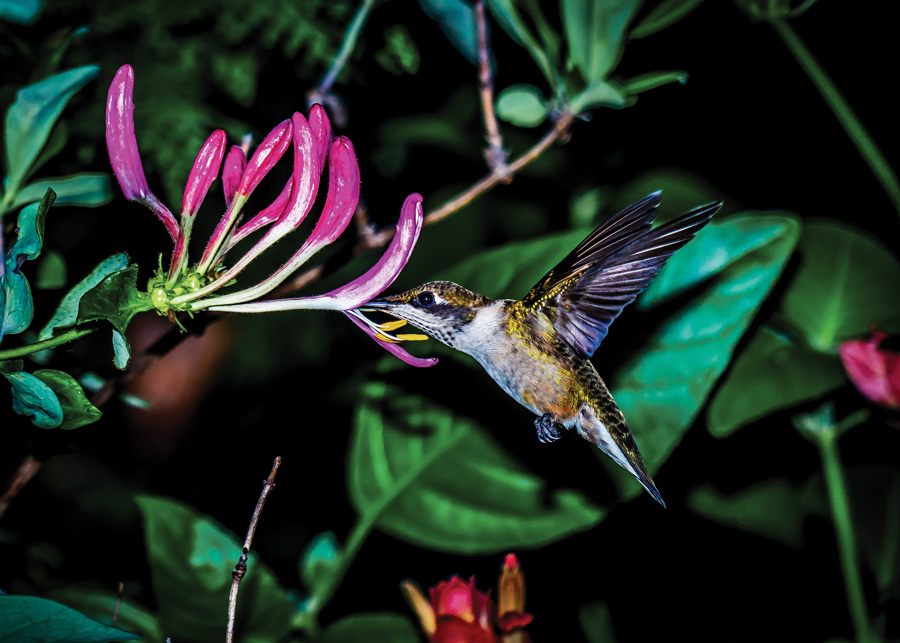
Those tiny bodies are vulnerable—a praying mantis can take down a hummingbird. But they radiate with energy that requires high-test fuel to beat their wings sixty times each second. That fuel comes in the form of nectar, the sweet liquid that hummingbirds procure with very long tongues that flick through their flower-probing bills to waiting reservoirs inside. So, if you want hummingbirds around, the first thing to consider is your flower selection!
Plants produce nectar expressly in order to attract pollinating animals. Many flowers available at commercial garden centers are hybrids that “self-deadhead”. That means they lose their flowers after they finish blooming, but before they produce seed. They lack the sex organs necessary to produce nectar. In many cases the hybrids produce more flowers, are hardier and more disease resistant. However, they do the pollinators—bees, butterflies and hummingbirds—no good. There are many techniques to bring about hybridization, and one can’t say they are all bad. Many occur naturally, even brought about by the pollinators themselves. But if you’re looking to attract hummingbirds to your place, be sure that your flowers have nectar.
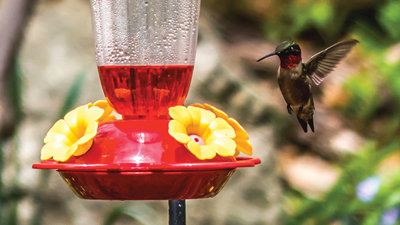
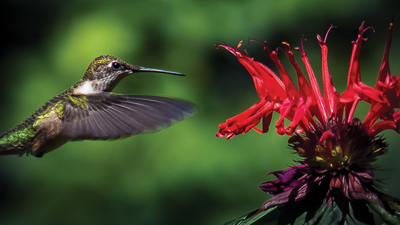
The relationship between plants and pollinators has evolved into an intricate dance and balance of co-dependencies. Nectar is a sugar-rich liquid regulated by the plant, depending upon visitation by pollinators. Nectar secretions increase with frequent visitation; decrease and reabsorb when visitations are limited. Hummingbirds and other pollinators favor certain types of flowers according to how their relationship has evolved.
If you don’t wish to commit to plants or flowers you can go the hummingbird feeder route. Most any store that sells birdseed, or even plants and flowers, will stock feeders. You can buy or make your own sugar water but just be sure to change it every three days so it doesn’t start to ferment. You don’t want to make your customers sick! We have a friend who lives fairly far out in the woods with a number of large feeders hanging from her deck. At any given time, there are several dozen hummingbirds feasting all at once on each feeder. I wouldn’t doubt she goes through a five-pound bag of sugar a week!
Hummingbirds are territorial, and in small enough numbers they will defend and drive off competing hummingbirds. But, like much of the natural world, they tend to adapt to more crowded conditions. Yielding their territoriality, you’ll find them hovering and feeding side by side with their brethren at the always-popular feeder. Personally, I have yet to get bitten by the hummingbird feeder bug, but I do have one to put out early in the season when there are only a few flowers. I find that hummingbirds prefer the plants, and I really enjoy trying new ones. But the plant/feeder mix is up to you, depending upon your aesthetics, budget and work commitment.
Hummingbirds have not only turned my thumb a bright green, transforming my backyard into an arboretum, they have sparked my interest in photography. It wasn’t until my friend Igor lent me his Canon camera with a 600 mm add-on lens that I was bitten by the shutter bug. To the naked eye, hummingbirds look like giant fuzzy bugs, and I was blown away by how detailed and revealing this medium could be. With hummingbirds constantly posing for the camera, the right equipment, and some patience, amazing pictures are sure to come.
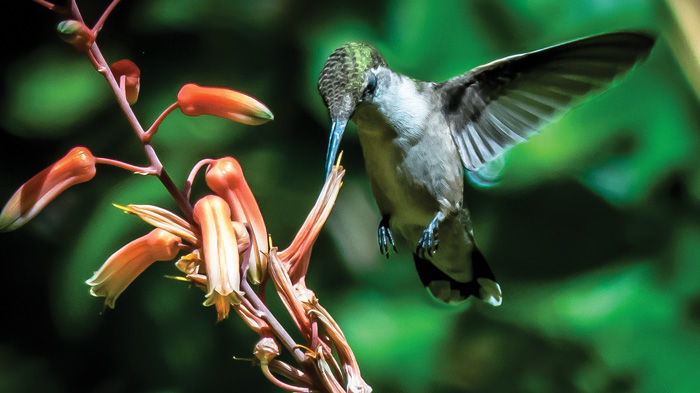
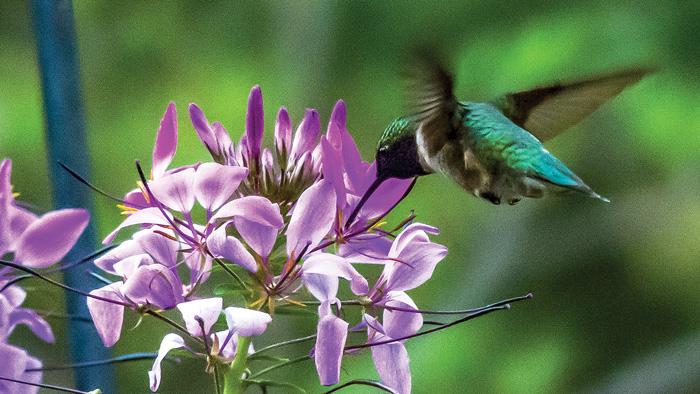
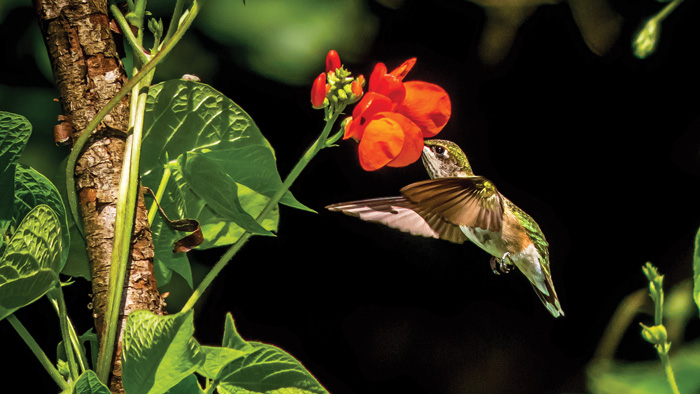
All-in-all I have hosted over 120 different kinds of flowers and plants in my backyard, but there are about a dozen regulars that I’ll tell you about. There are some varieties I’ve only been able to find once or twice, and there are others I’ve purchased in bulk every year. I can tell by the number of photographs I’ve taken the popularity they share among the hummingbirds and butterflies, and you might be surprised! Most people believe correctly that hummingbirds prefer red, and bees prefer the blue spectrum. But I have found the flower that hummingbirds prefer in my garden—by a factor of more than 2:1—is the black and blue salvia. I’m sure the fact that the spike set of flowers rising above the leaves adds to the likelihood of a nice photograph, but nothing else I have even comes close to this level of interest. I generally plant these in groups of three in fairly large one or two-gallon size pots. With the spiked flowers they’ll grow to a height of three feet. In any given year I may have several of these on my deck. Some years I find other varieties in slightly different colors of purple, red or pink which always leads to trying others. Another convenient aspect to this plant if you’re into photography is the fact the flowers run in a sequence, and the hummingbirds will generally follow this either up or down giving you time to adjust your camera’s eye. I particularly love to get an early morning or late afternoon shot with a flash for extra drama as it lends itself to a black background.
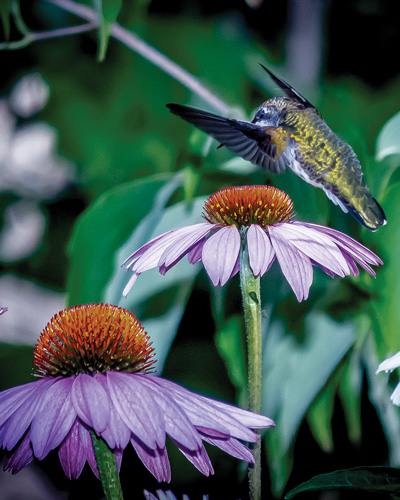
Our next strategy in setting the scene—and perhaps the biggest bang for no bucks—is to add appropriately shaped twigs, sticks or branches to your décor. This will give your guests a proper place to rest and significantly increase their residence time. It may take them less than a minute or two to service your average plant, but then they may take a break for a few minutes on a well-positioned twig or branch. Even better you’ll be able to look out your window and see them there while they survey their new territory. Ideally you’ll begin to understand what they are looking for and give them a choice in this regard. If your branch lies near a flower or two, or feeder, they may even take the easy way out and service them from a standing position. Some plants may have their own branches or trellis which provide them with this ability. If you don’t give your birds this option, they will likely find neighboring tree branches or shrubs to rest upon and your ability to see them will be diminished.
If you want to invite hummingbirds to your deck or porch, you can think about offering a habitat more to their liking. They’d probably like a bird bath, fountain for cooling, grassy plant for cover or cattails for nest-building material. Cattails also provide an interesting photo opportunity and are easy to find. I get probably three to six hummingbird visits per hour lasting maybe ten minutes each during the summer and early fall, with about half that in spring. Their feeding also increases when they are supporting their young and preparing to migrate. I attribute the drop off in spring to the local tree and flower bloom competition.
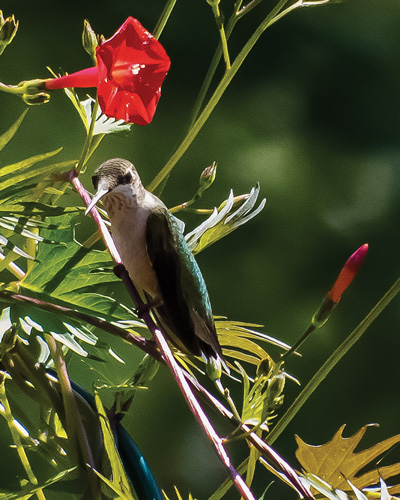
Another big factor in your strategy is bloom time. Many of the top flowers I recommend have continuous blooms for the entire seasonal sets while others are limited. You can move flowers in their pots into and out of your area of interest accordingly. For example, you might have columbine, Tahiti daffodils or bleeding hearts as early spring bloomers and move them to your regular garden as the bloom cycle season wraps up. I generally find these flowers will first bloom about the time the hummingbirds make their first migration appearance. Save some money for summer and fall acquisitions, and you can even follow the same course. Cardinal flowers, honeysuckle, bee balm and euchinacea make excellent early summer acquisitions as do crososmia Lucifer, canna and phlox. phlox and crososmia can be planted directly into the ground while you’ll need to store your canna bulbs in dry peat for the winter. Changing up the plants through the season will keep a variety of blooms and colors coming and make your area of interest more attractive. Planting throughout the season will also spread out your work effort and help to balance out your budget.
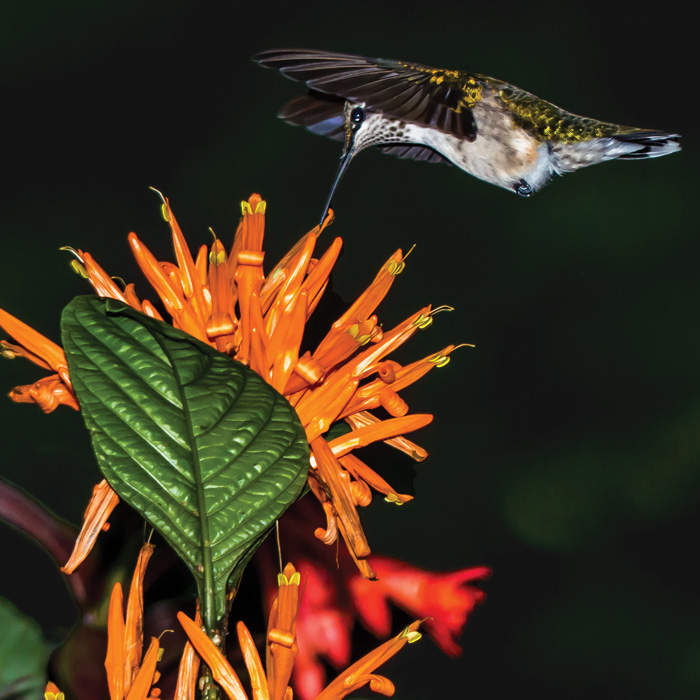
Other helpful, affordable additions to a deck garden are vines. Cardinal climber, cypress vine, red runner bean, purple hyacinth bean (and other beans), many varieties of morning glory and trumpet vine. You only need a large pot and trellis to make a beautiful single species or mixed varieties. These can be purchased as seed packages and planted indoors during late winter or found in garden centers as seedlings in container trays. They are easy to train and may be had for under a dollar a plant. Many are deer resistant and can be planted near mailboxes, lamp or fence posts. You can move these to your deck or patio area as soon as the season permits.
As a test I added plants to my mother-in-law’s deck gardens, a half-mile out in the woods. She initially had four deck-rail garden planters with white petunias. She was not seeing any hummingbird visits. I added several small plants of cuphea, red salvia and red fuchsia ‘Gartenmeister Bonstedt’ along with a few containers of black and blue salvia, lantana, cosmos, zinnia and cardinal climber. To give you an idea as to how far out in the woods we were, when I emptied her containers near a rock pile a bear jumped out! As I was finishing up the deck-rail planters a hummingbird showed up. Needless to say, her garden became a regular stop after that.
Of the 360 species of hummingbirds around the world, seven have been observed in New Jersey. Most of those have been considered occasional or “accidental”, and the only true local seasonal is the Ruby-throated Hummingbird. Named for the male’s iridescent red throat, Rubys, with a life span of three to five years, are about as long as your index finger and weigh less than a nickel. You’ll start to see them in late April when they arrive from points south, and by early fall they’re on their way back to Central America, with many crossing the Gulf of Mexico in a single flight. The only breeding hummingbird in eastern North America, female Rubys typically lay two tiny eggs in nests built on thin branches. Incubation lasts about two weeks and fledglings leave the nest after another three weeks. By then, mama Ruby may have already begun building her nest for a second round.
If you’re willing to invest a few bucks there are some outstanding tropicals which can be had such as shrimp plant (yellow or red), cannas, dark eyes fuchsia, justicia “orange firecracker”, firecracker fern and various aloe plants. These plants you’ll have to winter-over indoors as they will not survive otherwise. Proper placement will require moving them outside when warm enough and with the right amount of light and graduating them to sunlight. They offer some outstanding flower decorum.
One final thought for strategic placement of your plants is to consider how the hummingbirds need to service the flowers. In some instances, like fuchsia or ivy geraniums, the flowers hang down and open at the bottom. In general, I try to place these high for ease of access. Likewise, if the flowers open up and are approached from above, I place these lower in my range so the hummingbirds can bow down to reach them. Also, you would want to consider clustering them to provide an imposing appearance of a flower grouping rather than having them scattered about the deck. A great flower for this type of grouping is a red rocket salvia, and the more pot/dirt you give them the bigger they will grow. You can imagine how the striking image of such a flower grouping would prove irresistible to any passing stranger looking for a feast.

Although I’m not certain, I do believe about 99% of the several thousand hummingbird pictures I have taken are of Ruby-throated Hummingbirds. I may have a few Broad-tailed and Rufous or two, but aside from some of the females looking somewhat similar, I doubt I have seen many of the other varieties that have been reported in New Jersey. I suppose my indifference to what type of hummingbird I’m watching is compensated for by the stage of flowers they present themselves on. I do see different activities and styles of approach on the different flowers, and this is the variety that makes it interesting for me. I’ve seen many variations in personality as well. I’ve had some birds tap on my windows when it’s time to water my plants, and others chirp non-stop while feeding. My yard is heavily patrolled by deer so this gives me an opportunity to do a little gardening and have some good company with my morning coffee and afternoon drink. Do some experimenting and see what happens in your own hummingbird haven.
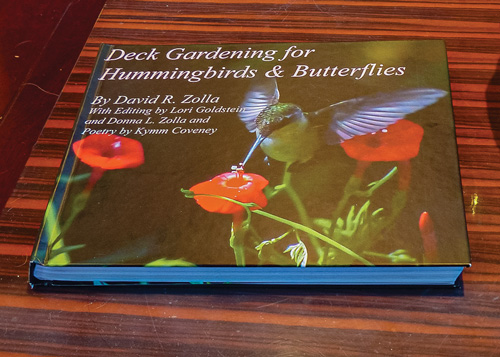
After my friend introduced me to photography, he suggested the Lumix FZ200 camera. He felt it was more affordable and forgiving than his Canon, with an excellent lens and shooting options. Photography reminded me a lot of fishing. You stalk your quarry in the elements and wait. It may be minutes or hours, but then the action starts, and you have to act quickly and decisively. At times you get about what you expected, but on occasion you are astonished by the unbelievable beauty or count of your catch.
I collected my favorite photos into a book that gives me something to keep and remember for all time. I hope to also make it available to others in order to perhaps expand their horizons even if only within the confines of a backyard. In some small way I would like to help turn the tide of habitat destruction by providing pollinators new stations to visit.
For updates on the status of Dave’s book email him at davez01@hotmail.com